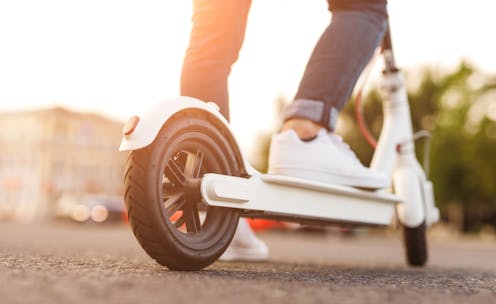
The first rental electric scooters quietly appeared on the streets of Brisbane in late 2018. Four years later, distinctively coloured e-scooters are seemingly everywhere, with trial schemes popping up in Melbourne, Sydney, Adelaide, Darwin and Perth.
Outside Australia, scooter share schemes are now operating in dozens of cities worldwide, and growth is expected to continue.
E-scooters offer commuters and tourists a way to cover shorter distances quickly – and without breaking a sweat. It’s for this reason Australian cities are trialling these schemes as part of broader interest in micromobility – small, light and often electric ways of getting around, such as bikes, e-bikes and e-scooters.
But one question previously unanswered is: what about the weather? If the skies open, do e-scooter users switch to cars or public transport? What about intense summer heat?
Our new research on the Brisbane e-scooter trial found trips actually increase as the heat rises, compared to human-powered bikes which see declining use in hotter weather.
When it’s wet, e-scooters remain more popular than bike share schemes – but not by much. We found around 32% of e-scooter trips take place in wet weather – compared to around 28% of bikesharing trips
What else did we find?
We looked at how e-scooter trips, destinations, and patterns of use vary based on weather. A large dataset of trips (more than 800,000) was provided to us by Neuron, one of the two scooter-sharing companies active in Brisbane.
We found e-scooter trips rise alongside the heat index, which measures the combined feeling of heat and humidity. People are likely to turn to them to avoid sweating up one of Brisbane’s many hills on foot.
Overall, and perhaps as expected, e-scooters are more appealing to people in Brisbane when it’s warm but lose appeal in wet conditions. Even so, it seems weather might matter less for e-scooters compared to bikesharing.
We found people tend to use scooters for recreation or to get somewhere fun, more than using them for utilitarian reasons such as going to work. But interestingly, utilitarian trips are becoming more common as people become more used to having scooters around.
As you might expect, e-scooter use is concentrated around the inner city, and trip lengths are mostly under 15 minutes. Users are typically younger, male and more educated – perhaps reflecting scooter locations where university students tend to live.
In Singapore, researchers have found e-scooter ridership actually falls as daytime temperatures rise. By contrast, in the Texas city of Austin, ridership falls when daytime temperatures get cooler and as wind rises.
Read more: Can e-scooters solve the 'last mile' problem? They'll need to avoid the fate of dockless bikes
Where and when do people scoot?
Most people take e-scooters along dedicated bike paths, such as the popular path along the Brisbane River. In fact, the riverfront bike path which runs through Brisbane is far and away the most popular location to scoot. The bike path is car-free, and connects the CBD to popular restaurant and nightlife strips.
During wet weather, scooter riders show an even greater preference for bike paths – potentially to avoid perceived heightened risk on slippery roads and footpaths.
Where are people going to? We found the overwhelming majority of places people start and end their trips are parks, strips of shops and suburbs, regardless of weather. Around one fifth of all trips are used to go from one residential suburb to another.
Weather plays a part here too. Wet weather trips tend to be shorter and more concentrated around the CBD and the river, possibly because most of Brisbane’s dedicated cycling infrastructure is here.
Bikesharing schemes have daily spikes in use for the morning and afternoon commutes as well as during lunchtime. By contrast, e-scooters see more use during the afternoon and evening. This indicates scooters are being used more as part of a night out or to get to dinner.

Why does this matter?
Though you might not think it – especially if you commute by car – weather plays a huge role in our daily decisions about how to get where we want to go. If heavy rain sets in, more people switch from bikes or public transport to cars.
The weather outside your front door influences where, when and how you travel. Scaled up, this means the weather can affect congestion, pollution and the experience of travel.
Weather has the most effect on transport modes where we’re not sheltered from the elements, such as walking and running, as well as micromobility modes such as shared e-scooters, e-bikes, bicycles and skateboards. Importantly, these modes are a vital part of making transport in cities sustainable.
Very few cities are trying to encourage more car traffic. By contrast, many are trying to create the conditions where walking, scooting and other non-polluting, space-minimal transport modes can flourish. Weather plays an important part in this. With climate breakdown looming, understanding weather impacts on travel has become crucial.
Read more: Too wet? Too cold? Too hot? This is how weather affects the trips we make
Anthony Kimpton has received funding from the Australian Research Infrastructure Netowrk (AURIN), and has been employed on multiple projects funded by the Australian Research Council (ARC).
Dorina Pojani has received research funding from the Australian Research Council (ARC) and the Australian Urban Research Infrastructure Network (AURIN)
Jonathan Corcoran receives funding from the Australian Research Council and the Australian Urban Research Infrastructure Network (AURIN).
Thomas Sigler receives funding from the Australian Research Council.
Julia Loginova and Richard Bean do not work for, consult, own shares in or receive funding from any company or organisation that would benefit from this article, and have disclosed no relevant affiliations beyond their academic appointment.
This article was originally published on The Conversation. Read the original article.







